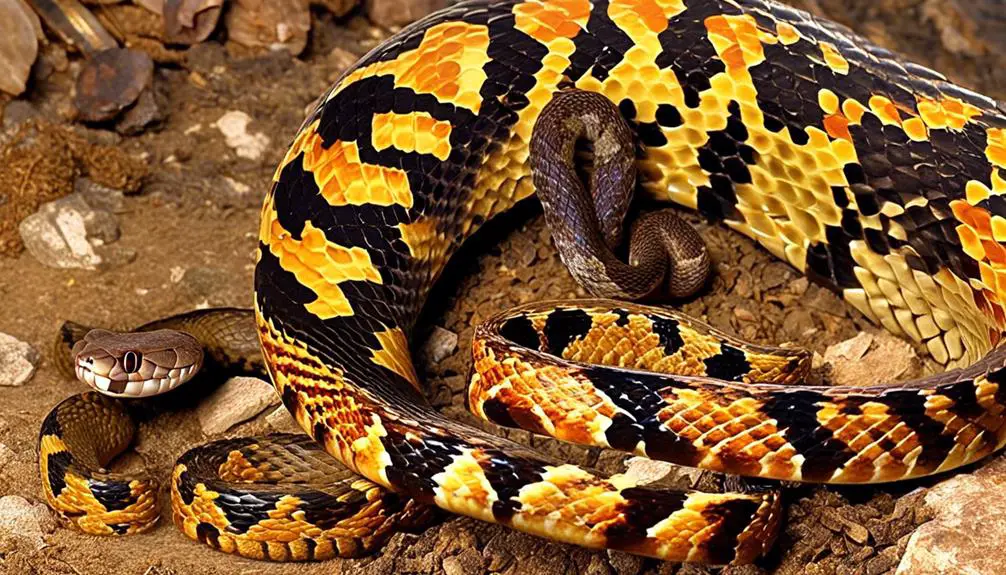Are you ready to step into the untamed wilderness of Spain? Brace yourself, for you are about to embark on a journey through a snake-infested labyrinth, where danger lurks at every turn.
As you navigate this treacherous terrain, you will encounter some of the deadliest serpents this country has to offer. From the venomous fangs of the Seoanes Viper to the stealthy slither of the Asp Viper, these creatures possess a lethal potency that can send shivers down your spine.
But fear not, dear adventurer, for knowledge is your shield, and understanding the habits and characteristics of these reptiles will be your key to survival.
So, tread carefully as we unravel the mysteries of Spain’s most venomous and dangerous snakes, and discover the vital role they play in the delicate tapestry of this mesmerizing land.
Seoanes Viper (Vipera seoanei)
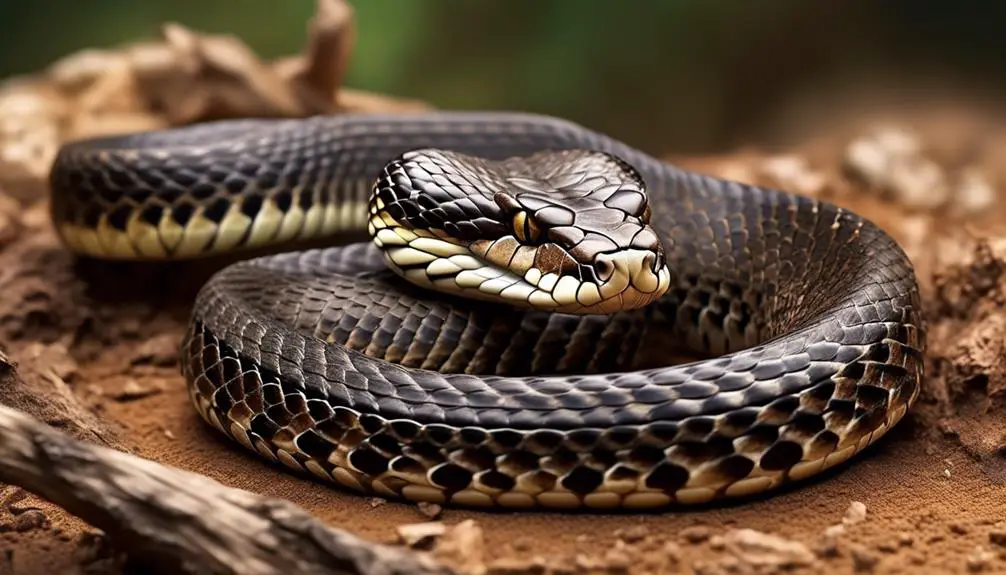
The Seoanes Viper, also known as Vipera seoanei, is a venomous snake found in southwestern France and northern parts of Spain and Portugal. This snake exhibits varying color patterns, including brown zig-zag and twin striped patterns. It has an average length of 45-50cm. The venom toxicity of the Seoanes Viper varies depending on the region, with the highest toxicity found in the Cantabrian mountains. While its bite is rarely fatal, it can deliver a painful bite. It’s important to note that this snake is legally protected in Spain.
In terms of snake protection in Spain, it’s crucial to understand that snakes play a vital role in maintaining the balance of the ecosystem. They help control the population of rodents and other pests, contributing to the overall health of the environment. Snakes can be found in various habitats, including forests, woodlands, grasslands, meadows, rocky areas, cliffs, wetlands, marshes, and even urban areas.
The Seoanes Viper, like other snakes, is an ectothermic reptile with an elongated body. It has specialized scales that aid in its movement. Most snakes, including the Seoanes Viper, are carnivorous, feeding on small mammals, birds, and reptiles. It’s important to note that snake bites should be treated to prevent infection, regardless of the venom potency.
Conservation efforts for snakes in Spain include the implementation of laws and regulations, awareness-raising campaigns, research and monitoring programs, habitat restoration projects, and public education and outreach programs. These efforts aim to protect and preserve the biodiversity of snakes in Spain.
Montpellier Snake (Malpolon monspessulanus)
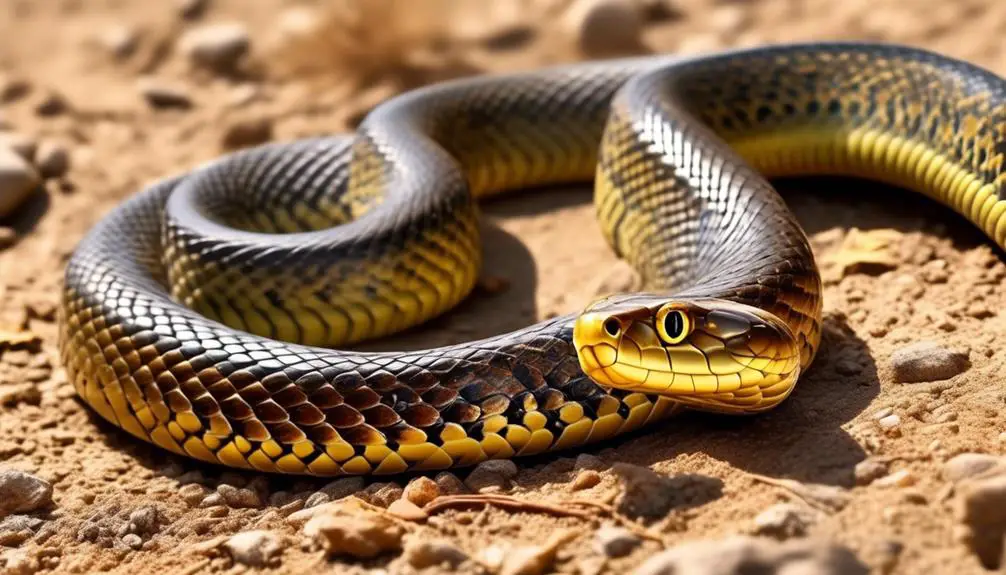
You will now delve into the subtopic of the Montpellier Snake (Malpolon monspessulanus), a venomous snake commonly found in the Mediterranean region.
The Montpellier Snake, also known as the False Smooth Snake, is the largest snake in Iberia, reaching lengths of up to 2 meters. It can be found in various habitats, including forests, woodlands, and rocky areas. The snake is typically gray, green, black, or brownish in color with spots.
Despite being venomous, the Montpellier Snake is non-aggressive and will only bite if threatened or cornered. However, venom injection is rare due to its rear fangs.
In terms of behavior, the Montpellier Snake is ectothermic, relying on external sources to regulate its body temperature. Like most snakes, it’s carnivorous, feeding on small mammals, birds, and reptiles.
Conservation efforts for the Montpellier Snake and other snake species in Spain include implementing protective laws, raising awareness, conducting research and monitoring programs, and restoring habitats.
Asp Viper (Vipera aspis)
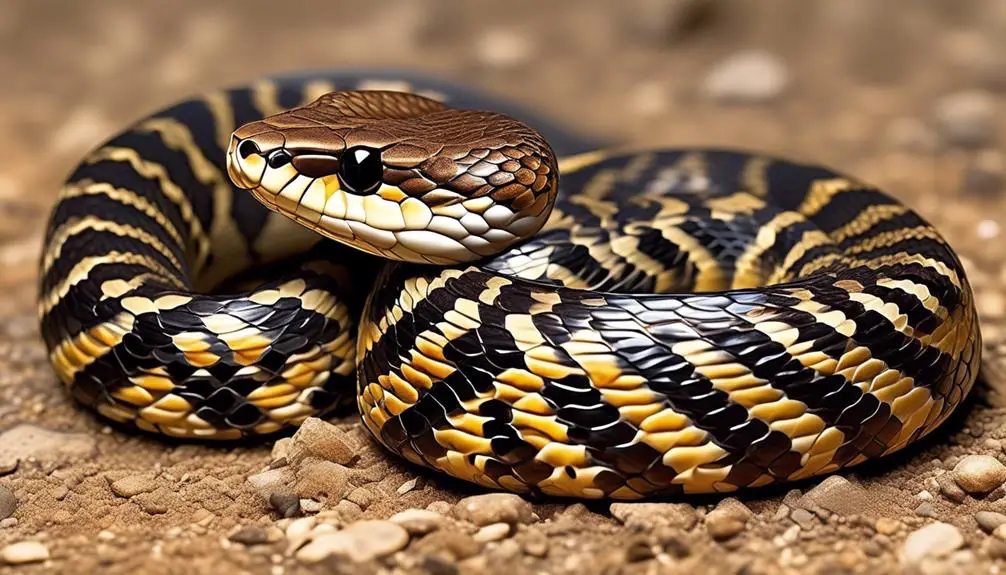
The Asp Viper (Vipera aspis) is one of the most dangerous snakes in Spain, as its bite can be fatal. With an average length of 60-65cm, it mainly inhabits the Pyrenees mountain range.
While it prefers to feed on lizards and small birds, it may bite humans if threatened, making immediate medical help necessary in case of a bite.
Fatal Bite Potential
With a fatal bite potential, the Asp Viper (Vipera aspis) is recognized as one of the most dangerous snakes in Spain. This venomous species, measuring an average length of 60-65cm, mainly inhabits the Pyrenees mountain range.
While the Asp Viper prefers to feed on lizards and small birds, it may bite humans if threatened. It’s crucial to seek immediate medical help if bitten by this snake.
The venom of the Asp Viper can cause severe symptoms, including tissue damage, internal bleeding, and organ failure. Prompt medical treatment is necessary to prevent the potentially fatal consequences of the bite.
Awareness and caution are essential when encountering the Asp Viper to avoid any unfortunate encounters.
Medical Response and Treatment
After encountering the Asp Viper (Vipera aspis) and recognizing its potential for a fatal bite, it’s crucial to understand the necessary medical response and treatment for this venomous snake species in Spain.
If bitten by an Asp Viper, it’s imperative to seek immediate medical help. The first step in treatment involves immobilizing the affected limb to prevent the venom from spreading.
Medical professionals will assess the severity of the bite and administer appropriate antivenom, which is the most effective treatment for venomous snake bites. It’s important to provide detailed information about the snake and the bite to the medical team.
They’ll closely monitor vital signs, administer pain relief, and address any complications that may arise, such as allergic reactions or infections.
Prompt medical attention is crucial to ensure the best possible outcome for individuals bitten by an Asp Viper.
Latastes Viper (Vipera latastei)
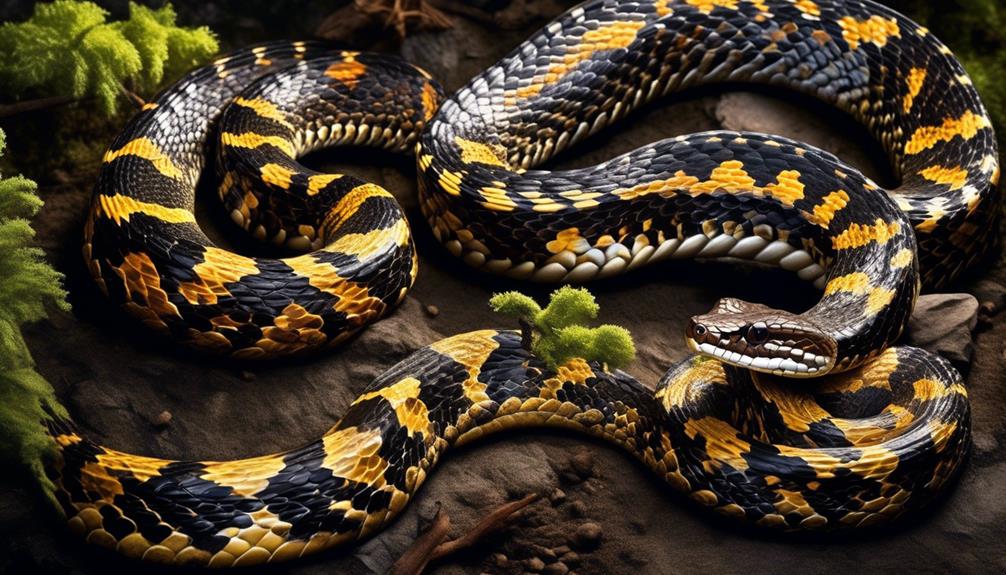
Found in dry, rocky areas of the Spanish Peninsula, the Latastes Viper (Vipera latastei) is characterized by its distinctive triangular head and dark zigzag pattern on its back. This venomous snake is generally calm and tends to flee when approached. However, it can attack if provoked, leading to symptoms such as vomiting and respiratory problems.
If you’re bitten by a Latastes Viper, it’s important to seek immediate medical attention. The venom of this species can cause significant harm and complications.
These vipers are known to inhabit a variety of habitats, including rocky areas and cliffs, where they can camouflage themselves and blend with their surroundings. It’s crucial to exercise caution when exploring such environments to avoid encounters with these venomous snakes.
False Smooth Snake (Macroprotodon cucullatus)
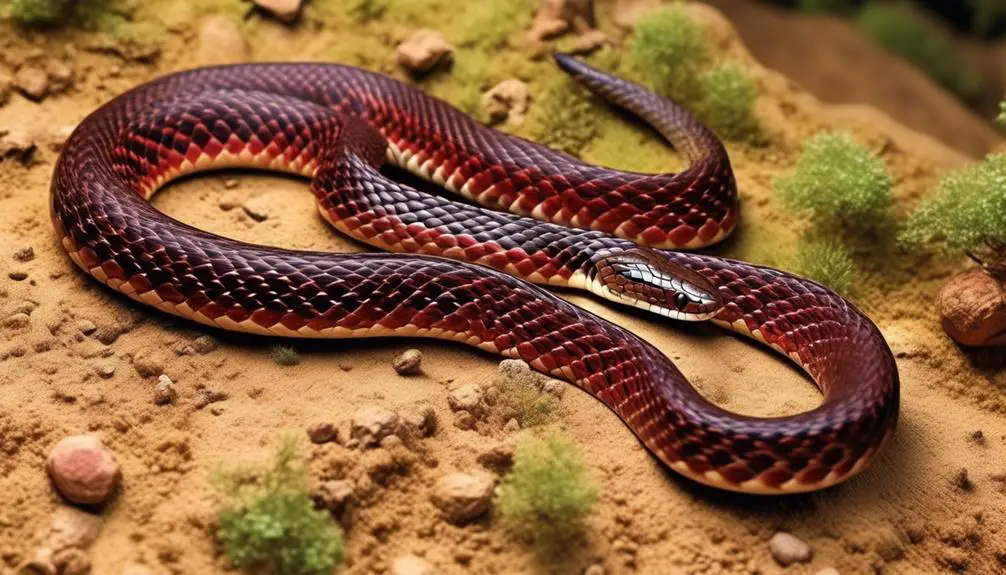
Continuing our exploration of venomous snakes in Spain, let’s now turn our attention to the False Smooth Snake (Macroprotodon cucullatus). This snake is endemic to the Mediterranean region, mainly found in the Catalonia region of Spain. It is gray or brown in color and has a maximum length of around 55cm. While the False Smooth Snake is venomous, its rear positioned fangs make a bite unlikely. Even if bitten, its mild venom poses low harm to humans. However, it is important to treat snake bites to prevent infection, regardless of the venom’s potency.
To summarize the key information about the False Smooth Snake, here is a table:
| Snake Species | False Smooth Snake (Macroprotodon cucullatus) |
|---|---|
| Endemic Region | Mediterranean |
| Main Distribution | Catalonia region of Spain |
| Color | Gray or brown |
| Maximum Length | Around 55cm |
| Venom Potency | Mild |
| Fang Position | Rear positioned |
| Bite Harm to Humans | Low |
Importance of Snake Protection

Snake protection is of utmost importance in Spain due to the legal benefits it provides and its role in maintaining the balance of the ecosystem.
By protecting snakes, you’re ensuring the preservation of biodiversity and contributing to the overall health of the environment.
Snakes play a crucial role in controlling the population of rodents and other pests, making their protection a vital aspect of conservation efforts.
Legal Protection Benefits
Snakes in Spain are legally protected, which serves to ensure the preservation of biodiversity and maintain the balance of the ecosystem. This legal protection benefits not only the snakes themselves but also the entire ecosystem they inhabit. By safeguarding these reptiles, we are indirectly protecting the various species that rely on them for food, such as birds and small mammals. Additionally, snakes play a crucial role in controlling the population of rodents and other pests, which helps to prevent the spread of diseases and maintain the health of agricultural lands. Furthermore, protecting snakes ensures the preservation of biodiversity, as they contribute to the overall health and stability of the environment. By implementing laws and regulations, the Spanish government, along with conservation organizations, is actively working towards the conservation and coexistence of snakes and humans.
| Legal Protection Benefits |
|---|
| Preservation of biodiversity |
| Maintenance of ecosystem balance |
| Control of pest populations |
This legal protection ensures that snakes are not harmed, killed, or captured, allowing them to fulfill their ecological roles and contribute to the overall health of the environment.
Ecosystem Balance Maintenance
To maintain the balance of the ecosystem, it’s crucial to protect and preserve the valuable role that snakes play in Spain’s biodiversity.
Snakes are an integral part of the food chain, controlling the population of rodents and other pests. By preying on these creatures, snakes help to maintain the population levels of their prey, preventing overpopulation and the subsequent negative impacts on the ecosystem.
Additionally, snakes contribute to the overall health of the environment by aiding in nutrient cycling through their role as decomposers.
Protecting snakes ensures the preservation of biodiversity, as they’re an essential component of Spain’s natural heritage.
Their conservation is necessary for the stability and sustainability of the ecosystem.
Snake Habitats in Spain

Various habitats in Spain serve as home to a diverse range of snake species. Snakes can be found in forests, woodlands, grasslands, meadows, rocky areas, cliffs, wetlands, marshes, and even urban areas. They adapt to different environments, showcasing their ability to survive and thrive in various conditions. To give you a visual representation of snake habitats in Spain, here is a table:
| Habitat | Description | Snake Species Found |
|---|---|---|
| Forests | Areas with dense tree coverage | Seoanes Viper, Montpellier Snake |
| Woodlands | Areas with scattered trees and shrubs | Asp Viper, Latastes Viper |
| Grasslands | Open areas with grasses and herbs | False Smooth Snake |
| Meadows | Open areas with grass and wildflowers | False Smooth Snake |
| Rocky areas | Areas with rocky outcrops and boulders | Latastes Viper |
| Cliffs | Steep, vertical rock formations | Latastes Viper |
| Wetlands | Areas with standing water | Seoanes Viper |
| Marshes | Wetland areas with water and vegetation | Seoanes Viper |
| Urban areas | Human settlements and developed areas | Montpellier Snake |
Snake Behavior and Characteristics
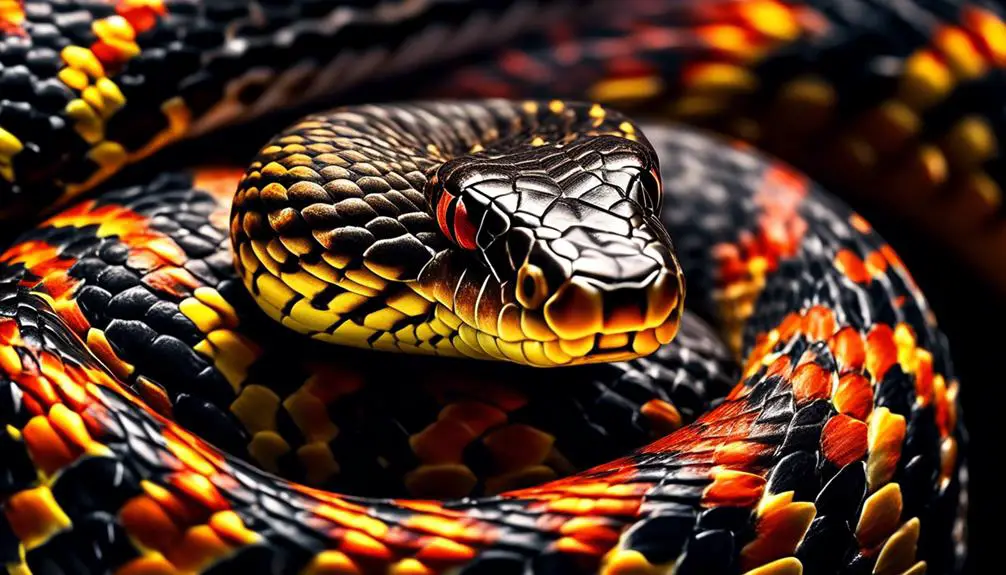
Moving on from discussing the different habitats where snakes can be found in Spain, let’s now explore the fascinating behavior and unique characteristics of these remarkable reptiles.
Snakes, being ectothermic, rely on external sources to regulate their body temperature. They’ve elongated bodies and are limbless reptiles. Snakes possess specialized scales that aid in their movement. Most snakes are carnivorous, preying on small mammals, birds, and reptiles. However, some snake species have the ability to deliver venomous bites for hunting or defense purposes.
In Spain, venomous snakes such as the Seoane’s Viper, Montpellier Snake, Asp Viper, and Latastes Viper exhibit distinct behavior patterns. While the Seoane’s Viper rarely delivers fatal bites, it can inflict a painful bite. The Montpellier Snake, although non-aggressive, can become defensive when threatened or cornered. The Asp Viper, on the other hand, is one of the most dangerous snakes in Spain, with a potentially fatal bite. Lastly, the Latastes Viper is generally calm and tends to flee when approached, but can attack if provoked.
It is important to note that the False Smooth Snake, although non-venomous, can still cause harm through bites. Regardless of venom potency, all snake bites should be treated to prevent infection. Understanding the behavior and characteristics of snakes in Spain is crucial for coexisting with these reptiles in a safe and informed manner.
Conservation Efforts for Snakes in Spain

Conservation efforts in Spain are focused on protecting and preserving the diverse snake species found within the country. The Spanish government has implemented laws and regulations to safeguard these reptiles. Conservation organizations play a crucial role in raising awareness about the importance of snake conservation. Research and monitoring programs are conducted to gain a better understanding of snake populations and their habitats.
Habitat restoration projects are also underway to create suitable environments for snakes. These projects aim to improve the quality and availability of habitats such as forests, woodlands, grasslands, meadows, rocky areas, cliffs, wetlands, marshes, and even urban areas. By restoring these habitats, snakes are provided with the resources they need to thrive.
Public education and outreach programs are essential in promoting coexistence with snakes and dispelling myths. These initiatives aim to educate the public about the importance of snakes in maintaining the balance of the ecosystem. By fostering a better understanding and appreciation for these reptiles, it becomes easier to protect their habitats and ensure their long-term survival.

Erzsebet Frey (Eli Frey) is an ecologist and online entrepreneur with a Master of Science in Ecology from the University of Belgrade. Originally from Serbia, she has lived in Sri Lanka since 2017. Eli has worked internationally in countries like Oman, Brazil, Germany, and Sri Lanka. In 2018, she expanded into SEO and blogging, completing courses from UC Davis and Edinburgh. Eli has founded multiple websites focused on biology, ecology, environmental science, sustainable and simple living, and outdoor activities. She enjoys creating nature and simple living videos on YouTube and participates in speleology, diving, and hiking.
- WILDLIFE THEMED T-SHIRTS
Cute Hedgehog Embroidered: Love Wildlife, Protect Nature Wildlife conservation tees
$35.00

